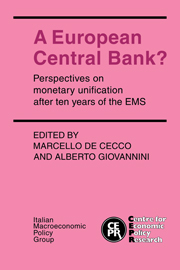Book contents
- Frontmatter
- Contents
- List of figures
- List of tables
- Preface
- List of conference participants
- 1 Does Europe need its own central bank?
- 2 Monetary policy, capital controls and seigniorage in an open economy
- 3 Seigniorage in Europe
- 4 Factor mobility, uncertainty and exchange rate regimes
- 5 Management of a common currency
- 6 The tastes of European central bankers
- 7 The costs and benefits of a European currency
- 8 The monetary unification process in nineteenth-century Germany: relevance and lessons for Europe today
- 9 The establishment of a central bank: Italy in the nineteenth century
- 10 The founding of the Fed and the destabilization of the post-1914 US economy
- 11 Panel discussion on the prospects for a European Central Bank
- Index
7 - The costs and benefits of a European currency
Published online by Cambridge University Press: 05 February 2012
- Frontmatter
- Contents
- List of figures
- List of tables
- Preface
- List of conference participants
- 1 Does Europe need its own central bank?
- 2 Monetary policy, capital controls and seigniorage in an open economy
- 3 Seigniorage in Europe
- 4 Factor mobility, uncertainty and exchange rate regimes
- 5 Management of a common currency
- 6 The tastes of European central bankers
- 7 The costs and benefits of a European currency
- 8 The monetary unification process in nineteenth-century Germany: relevance and lessons for Europe today
- 9 The establishment of a central bank: Italy in the nineteenth century
- 10 The founding of the Fed and the destabilization of the post-1914 US economy
- 11 Panel discussion on the prospects for a European Central Bank
- Index
Summary
Introduction
What should one fear or hope from a supranational currency in Europe? That it will offer a means to enhance the collective rationality of European economic policies, or that it will restrict the sovereignty of each national government? That it will help to smooth balance-of-payments disequilibria, or give a blank cheque to profligate governments? These are some of the questions that occur to every policymaker when considering whether or not to support the monetary unification of Europe.
History, it is true, does not plead in its favour. As reviewed in Hamada (1985), examples of supranational monetary integration are rare and usually short-lived (while trade agreements are numerous and longlasting). In the post-World War II era, the failure of the Allies to agree upon Keynes's plan for world monetary integration and the later demise of the ephemeral European Payments Union are vivid illustrations of the difficulties involved. In this paper, however, it will be argued that both Keynes's plan and the EPU were misconceived and should not be regarded as omens of failure for European monetary integration.
In Section 2, I seek to demonstrate that Keynes's plan rested on a confusion between the management of the deficit countries' budget constraint and the issue of macroeconomic policy coordination. The following section draws the lessons of this for European monetary union. Section 4 reviews the likely effects of monetary integration on economic policies. The conclusion offers a few practical remarks on the transition path to a European monetary union.
- Type
- Chapter
- Information
- A European Central Bank?Perspectives on Monetary Unification after Ten Years of the EMS, pp. 195 - 215Publisher: Cambridge University PressPrint publication year: 1989
- 9
- Cited by



